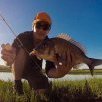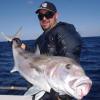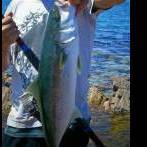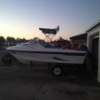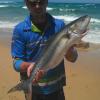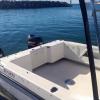-
Content Count
30 -
Joined
-
Last visited
-
Days Won
1
Reputation Activity
-
 Hiramasa reacted to bjorn2fish in My first attempt at DIY berley blocks
Hiramasa reacted to bjorn2fish in My first attempt at DIY berley blocks
I finally got around to making a batch of berley blocks.
Ingredients included old bait like cockles, a few weird looking pillies, salmon trout, salmon frames, tommies, fresh prawn shells, squid, some old snapper and stale bread, I think that was about it.
Some nice containers ready to use. I saved a few round containers so the berley could go in those small, screw top, plastic berley pots.
My berley BEAST! Ok not a beast. I actually chipped the blades on the fish frames
The berley mix looked awesome and sooo very tasty.
Packed and ready to freeze.
Now I just have to get out on the water and give them a go
I'll definitely have to make more at some stage.
-

-
 Hiramasa got a reaction from Alexsfishin1 in Port Noarlunga ST Bag out
Hiramasa got a reaction from Alexsfishin1 in Port Noarlunga ST Bag out
Well done mate, impressive haul.
-

-
 Hiramasa got a reaction from bjorn2fish in Berley...What ingredients and how do you do it?
Hiramasa got a reaction from bjorn2fish in Berley...What ingredients and how do you do it?
I just put the whole snapper block in a scaler bag mate. It's weighed down with a 9lb dive weight as they tend to want to float when still frozen solid.
The whiting burley I leave chunky and use a wire mesh cage style burley pot. I find with whiting the smell will keep them close as much as the food itself. Plus if u leave it chunky the wire cage will break off small particles. I find if I mash it up it doesn't last long enough.
-
 Hiramasa got a reaction from bjorn2fish in Berley...What ingredients and how do you do it?
Hiramasa got a reaction from bjorn2fish in Berley...What ingredients and how do you do it?
Here's my burley selection for different species:
Snapper: frozen burley block from the tackle shop.
Tommies / gar: off the shelf chook pellets soaked in tuna oil
Whiting: pilchards, old cockles, squid heads. Basically anything but pellets as I find pellet burley on the bottom just brings in the crappies and tends to spook the whiting.
-
 Hiramasa got a reaction from Ale in Berley...What ingredients and how do you do it?
Hiramasa got a reaction from Ale in Berley...What ingredients and how do you do it?
Here's my burley selection for different species:
Snapper: frozen burley block from the tackle shop.
Tommies / gar: off the shelf chook pellets soaked in tuna oil
Whiting: pilchards, old cockles, squid heads. Basically anything but pellets as I find pellet burley on the bottom just brings in the crappies and tends to spook the whiting.
-
 Hiramasa reacted to bjorn2fish in Home Made Snapper Micro Jigs.
Hiramasa reacted to bjorn2fish in Home Made Snapper Micro Jigs.
Those jigs look awesome. I'd love to see them in action.
-
 Hiramasa got a reaction from Cal in Home Made Snapper Micro Jigs.
Hiramasa got a reaction from Cal in Home Made Snapper Micro Jigs.
After having a lot of success last snapper season using jigs and switchblades and with this weather not allowing much fishing time I hit the shed to make up a new assortment of micro jigs. I came up with my own idea of using old salmon lures, old lucanus style jigs, and plastic squid to make up the jig.
The plastic squid retail at $2:95 per pack for 5. A pack of decent jig assist hooks are also cheap as the quality only needs to be good enough for big snapper. I used Williamson assist hooks, but as per one of the pics you can also just use standard 8/0 suicides and 80lb leader to form your own assist hook. Add in a few split rings and youre in business. Each of the jigs below range from 70g through to 100g. I prefer them heavy as I fish deep drops for reds and heavier jigs allow you to 'bounce' the jig along the bottom and get it down easier in stronger tides.
The metal part of the jig (salmon lure) doesn't need to be anything fancy, as it only acts as the weight to get it down.. it's the squid with the hook that does the damage.
I've found that these work best for drifting across the drop. My technique is to firstly use the sounder to find the fish, then once they appear on the screen cast the jig up drift of the fish. This will allow the jig time to sink. I then simply bounce the jig along the bottom through the school. Usually it gets taken on the drop as it's bounced along the bottom.
Snapper tend to fight much harder if the boat is drifting, not anchored. They can petty much free swim when drifting instead of being yanked into the current.
Here's a few pics of the jigs both on the table and how they would appear in the water. Add in a light rod, 10lb braid and hang on!
-
 Hiramasa got a reaction from keenfisho in Home Made Snapper Micro Jigs.
Hiramasa got a reaction from keenfisho in Home Made Snapper Micro Jigs.
After having a lot of success last snapper season using jigs and switchblades and with this weather not allowing much fishing time I hit the shed to make up a new assortment of micro jigs. I came up with my own idea of using old salmon lures, old lucanus style jigs, and plastic squid to make up the jig.
The plastic squid retail at $2:95 per pack for 5. A pack of decent jig assist hooks are also cheap as the quality only needs to be good enough for big snapper. I used Williamson assist hooks, but as per one of the pics you can also just use standard 8/0 suicides and 80lb leader to form your own assist hook. Add in a few split rings and youre in business. Each of the jigs below range from 70g through to 100g. I prefer them heavy as I fish deep drops for reds and heavier jigs allow you to 'bounce' the jig along the bottom and get it down easier in stronger tides.
The metal part of the jig (salmon lure) doesn't need to be anything fancy, as it only acts as the weight to get it down.. it's the squid with the hook that does the damage.
I've found that these work best for drifting across the drop. My technique is to firstly use the sounder to find the fish, then once they appear on the screen cast the jig up drift of the fish. This will allow the jig time to sink. I then simply bounce the jig along the bottom through the school. Usually it gets taken on the drop as it's bounced along the bottom.
Snapper tend to fight much harder if the boat is drifting, not anchored. They can petty much free swim when drifting instead of being yanked into the current.
Here's a few pics of the jigs both on the table and how they would appear in the water. Add in a light rod, 10lb braid and hang on!
-
 Hiramasa reacted to Cal in Home Made Snapper Micro Jigs.
Hiramasa reacted to Cal in Home Made Snapper Micro Jigs.
They look excellent mate ,nice work.
A thing I do with those plastic squid is you get polystyrene balls from craft,cheap shops like spotlight[2$ for about 20] poke a hole in them and insert them into the head of those plastic squid.
Thread line through and tie on a hook,they make the best surf poppers ,heaps better than the ones you buy as they are more durable and you can put on a quality hook of your choice.
Cheers
-
 Hiramasa got a reaction from dylzzz69 in Home Made Snapper Micro Jigs.
Hiramasa got a reaction from dylzzz69 in Home Made Snapper Micro Jigs.
After having a lot of success last snapper season using jigs and switchblades and with this weather not allowing much fishing time I hit the shed to make up a new assortment of micro jigs. I came up with my own idea of using old salmon lures, old lucanus style jigs, and plastic squid to make up the jig.
The plastic squid retail at $2:95 per pack for 5. A pack of decent jig assist hooks are also cheap as the quality only needs to be good enough for big snapper. I used Williamson assist hooks, but as per one of the pics you can also just use standard 8/0 suicides and 80lb leader to form your own assist hook. Add in a few split rings and youre in business. Each of the jigs below range from 70g through to 100g. I prefer them heavy as I fish deep drops for reds and heavier jigs allow you to 'bounce' the jig along the bottom and get it down easier in stronger tides.
The metal part of the jig (salmon lure) doesn't need to be anything fancy, as it only acts as the weight to get it down.. it's the squid with the hook that does the damage.
I've found that these work best for drifting across the drop. My technique is to firstly use the sounder to find the fish, then once they appear on the screen cast the jig up drift of the fish. This will allow the jig time to sink. I then simply bounce the jig along the bottom through the school. Usually it gets taken on the drop as it's bounced along the bottom.
Snapper tend to fight much harder if the boat is drifting, not anchored. They can petty much free swim when drifting instead of being yanked into the current.
Here's a few pics of the jigs both on the table and how they would appear in the water. Add in a light rod, 10lb braid and hang on!
-
 Hiramasa got a reaction from Rod in Home Made Snapper Micro Jigs.
Hiramasa got a reaction from Rod in Home Made Snapper Micro Jigs.
After having a lot of success last snapper season using jigs and switchblades and with this weather not allowing much fishing time I hit the shed to make up a new assortment of micro jigs. I came up with my own idea of using old salmon lures, old lucanus style jigs, and plastic squid to make up the jig.
The plastic squid retail at $2:95 per pack for 5. A pack of decent jig assist hooks are also cheap as the quality only needs to be good enough for big snapper. I used Williamson assist hooks, but as per one of the pics you can also just use standard 8/0 suicides and 80lb leader to form your own assist hook. Add in a few split rings and youre in business. Each of the jigs below range from 70g through to 100g. I prefer them heavy as I fish deep drops for reds and heavier jigs allow you to 'bounce' the jig along the bottom and get it down easier in stronger tides.
The metal part of the jig (salmon lure) doesn't need to be anything fancy, as it only acts as the weight to get it down.. it's the squid with the hook that does the damage.
I've found that these work best for drifting across the drop. My technique is to firstly use the sounder to find the fish, then once they appear on the screen cast the jig up drift of the fish. This will allow the jig time to sink. I then simply bounce the jig along the bottom through the school. Usually it gets taken on the drop as it's bounced along the bottom.
Snapper tend to fight much harder if the boat is drifting, not anchored. They can petty much free swim when drifting instead of being yanked into the current.
Here's a few pics of the jigs both on the table and how they would appear in the water. Add in a light rod, 10lb braid and hang on!
-
 Hiramasa reacted to trihull in Home Made Snapper Micro Jigs.
Hiramasa reacted to trihull in Home Made Snapper Micro Jigs.
Saw a YouTube clip on those, you know you could also add the larger lumo beads into the heads of the plastic squids..... fills them out better and stops squid from fouling hook
Well Done !!!!
-
 Hiramasa got a reaction from piratepom in Home Made Snapper Micro Jigs.
Hiramasa got a reaction from piratepom in Home Made Snapper Micro Jigs.
After having a lot of success last snapper season using jigs and switchblades and with this weather not allowing much fishing time I hit the shed to make up a new assortment of micro jigs. I came up with my own idea of using old salmon lures, old lucanus style jigs, and plastic squid to make up the jig.
The plastic squid retail at $2:95 per pack for 5. A pack of decent jig assist hooks are also cheap as the quality only needs to be good enough for big snapper. I used Williamson assist hooks, but as per one of the pics you can also just use standard 8/0 suicides and 80lb leader to form your own assist hook. Add in a few split rings and youre in business. Each of the jigs below range from 70g through to 100g. I prefer them heavy as I fish deep drops for reds and heavier jigs allow you to 'bounce' the jig along the bottom and get it down easier in stronger tides.
The metal part of the jig (salmon lure) doesn't need to be anything fancy, as it only acts as the weight to get it down.. it's the squid with the hook that does the damage.
I've found that these work best for drifting across the drop. My technique is to firstly use the sounder to find the fish, then once they appear on the screen cast the jig up drift of the fish. This will allow the jig time to sink. I then simply bounce the jig along the bottom through the school. Usually it gets taken on the drop as it's bounced along the bottom.
Snapper tend to fight much harder if the boat is drifting, not anchored. They can petty much free swim when drifting instead of being yanked into the current.
Here's a few pics of the jigs both on the table and how they would appear in the water. Add in a light rod, 10lb braid and hang on!
-
 Hiramasa got a reaction from bjorn2fish in Home Made Snapper Micro Jigs.
Hiramasa got a reaction from bjorn2fish in Home Made Snapper Micro Jigs.
After having a lot of success last snapper season using jigs and switchblades and with this weather not allowing much fishing time I hit the shed to make up a new assortment of micro jigs. I came up with my own idea of using old salmon lures, old lucanus style jigs, and plastic squid to make up the jig.
The plastic squid retail at $2:95 per pack for 5. A pack of decent jig assist hooks are also cheap as the quality only needs to be good enough for big snapper. I used Williamson assist hooks, but as per one of the pics you can also just use standard 8/0 suicides and 80lb leader to form your own assist hook. Add in a few split rings and youre in business. Each of the jigs below range from 70g through to 100g. I prefer them heavy as I fish deep drops for reds and heavier jigs allow you to 'bounce' the jig along the bottom and get it down easier in stronger tides.
The metal part of the jig (salmon lure) doesn't need to be anything fancy, as it only acts as the weight to get it down.. it's the squid with the hook that does the damage.
I've found that these work best for drifting across the drop. My technique is to firstly use the sounder to find the fish, then once they appear on the screen cast the jig up drift of the fish. This will allow the jig time to sink. I then simply bounce the jig along the bottom through the school. Usually it gets taken on the drop as it's bounced along the bottom.
Snapper tend to fight much harder if the boat is drifting, not anchored. They can petty much free swim when drifting instead of being yanked into the current.
Here's a few pics of the jigs both on the table and how they would appear in the water. Add in a light rod, 10lb braid and hang on!
-
 Hiramasa got a reaction from Ale in Home Made Snapper Micro Jigs.
Hiramasa got a reaction from Ale in Home Made Snapper Micro Jigs.
After having a lot of success last snapper season using jigs and switchblades and with this weather not allowing much fishing time I hit the shed to make up a new assortment of micro jigs. I came up with my own idea of using old salmon lures, old lucanus style jigs, and plastic squid to make up the jig.
The plastic squid retail at $2:95 per pack for 5. A pack of decent jig assist hooks are also cheap as the quality only needs to be good enough for big snapper. I used Williamson assist hooks, but as per one of the pics you can also just use standard 8/0 suicides and 80lb leader to form your own assist hook. Add in a few split rings and youre in business. Each of the jigs below range from 70g through to 100g. I prefer them heavy as I fish deep drops for reds and heavier jigs allow you to 'bounce' the jig along the bottom and get it down easier in stronger tides.
The metal part of the jig (salmon lure) doesn't need to be anything fancy, as it only acts as the weight to get it down.. it's the squid with the hook that does the damage.
I've found that these work best for drifting across the drop. My technique is to firstly use the sounder to find the fish, then once they appear on the screen cast the jig up drift of the fish. This will allow the jig time to sink. I then simply bounce the jig along the bottom through the school. Usually it gets taken on the drop as it's bounced along the bottom.
Snapper tend to fight much harder if the boat is drifting, not anchored. They can petty much free swim when drifting instead of being yanked into the current.
Here's a few pics of the jigs both on the table and how they would appear in the water. Add in a light rod, 10lb braid and hang on!
-
 Hiramasa got a reaction from Ale in Leader knot recommendations?
Hiramasa got a reaction from Ale in Leader knot recommendations?
I use the Surgeons Knot mate, very simple but very strong. Easy to tie in the dark and in rough seas.
Check it out on YouTube.





